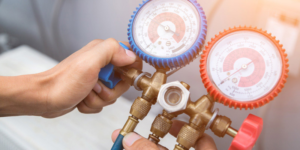An HVAC system in a restaurant plays a crucial role in creating a comfortable and inviting atmosphere for both diners and staff. It goes beyond just keeping things cool or warm.
Here’s a breakdown of its key functions:
Temperature Control:
Maintaining a comfortable temperature throughout the restaurant is essential for guest comfort. The HVAC system ensures a pleasant dining experience, especially during hot or cold weather.
Kitchen Heat Management:
Restaurant kitchens are notoriously hot due to cooking equipment. The HVAC system removes this excess heat and fumes, preventing the dining area from becoming uncomfortably warm and stuffy.
Ventilation and Air Quality:
Exhaust ventilation is crucial to eliminate cooking odors, smoke, and grease from the kitchen, preventing them from lingering in the dining area. Proper ventilation also helps maintain good air quality by removing airborne contaminants and ensuring fresh air circulation.
Humidity Control:
In high-humidity environments, an HVAC system can help regulate moisture levels, preventing condensation on windows or walls and creating a more comfortable atmosphere for everyone.

Restaurant HVAC Systems: Unique Needs
Compared to typical residential or commercial HVAC systems, restaurants have specific needs:
- Higher Heat Generation: Kitchens produce significant heat, requiring a system capable of handling the extra load.
- Ventilation Demands: Exhaust systems need to be powerful enough to remove cooking odors and grease effectively.
- Zoned Control: Different areas of a restaurant (kitchen, dining area, restrooms) might require different temperature settings. Zoned HVAC systems can cater to these variations.
Types of HVAC Systems Used in Restaurants:
There are various HVAC system options suitable for restaurants, depending on factors like size, budget, and layout. Here are two common choices:
- Split Systems: These consist of separate indoor and outdoor units. They are a popular option for smaller restaurants and offer good temperature control.
- Packaged Rooftop Units (RTUs): These self-contained units are located on the roof and offer efficient heating, cooling, and ventilation for larger restaurants.
Conclusion:
A well-designed and maintained HVAC system is vital for a successful restaurant. It ensures a comfortable dining experience, helps maintain good air quality, and protects equipment from overheating. By understanding the unique needs of restaurants, HVAC professionals can design a system that keeps your restaurant running smoothly and your guests happy.
